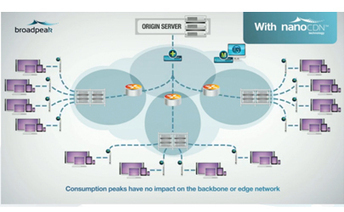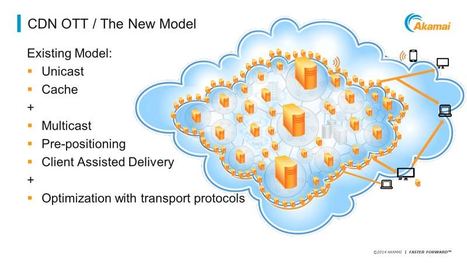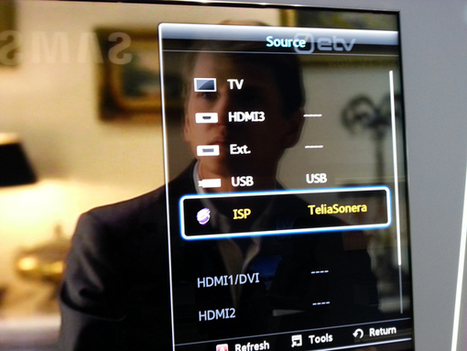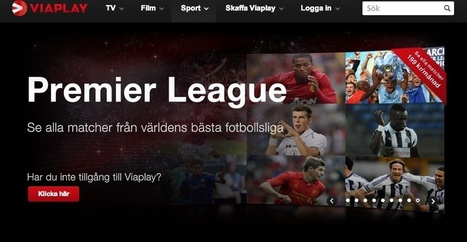 Your new post is loading...
 Your new post is loading...
As we reported previously, the Broadpeak solution introduces very lightweight clients into the home router/gateway and these intercept the unicast stream requests made by a tablet or smartphone to an origin server. The client looks for a multicast stream of the linear content instead. The platform operator works with a content owner to make the most popular channels available in multicast, perhaps during peak times or for popular shows or live sports, or even 24/7. The nanoCDN client receives this multicast stream instead, then converts it to unicast ABR (adaptive bit rate) inside the home so it can be watched on the multiscreen devices without any changes to their apps.
By replacing multiple unicast streams with a single multicast stream in the broadband network, nanoCDN reduces the bandwidth demands for linear/live video. nanoCDN is pioneering because of the way it harnesses multicast within a CDN environment and because it makes in-home devices an extension of the CDN.
Akamai has been providing a number of clues about how the company intends to dramatically increase the performance of the Internet for video streaming to support Ultra HD and ultimately match the scale and quality of broadcast TV. One big clue could be found on the Qualcomm stand at International CES 2014 when that company’s subsidiary, Qualcomm Atheros, was demonstrating its IPQ home gateway. Among other things this included a proof-of-concept client software from Akamai that is designed to optimize the delivery and pre-positioning of content like video and software.
The client software is not a product yet but Akamai is certainly talking as if it will be. Kris Alexander, Chief Strategist, Connected Devices & Gaming at Akamai, says, “The demo offers a glimpse into the future of the Akamai platform as we explore ways to move beyond the edge and onto devices of many types – not only gateways but game consoles, set-top-boxes, Blu-ray players, connected TVs and more.”
As the multicast standard for Long Term Evolution (LTE), Enhanced Multimedia Broadcast Multicast Service (eMBMS) was introduced by Third Generation Partnership Project (3GPP) to facilitate delivery of popular content to multiple users over a cellular network. If a large number of users is interested in the same content, for e.g., live sports, news clips, etc., multicast transmission can significantly lower the cost and make better use of the spectrum as compared to unicast transmission.
In this paper, we study and analyze the quality of experience (QoE) at the end user during live video streaming over eMBMS. We consider a comprehensive end-to-end MBMS streaming frame-work based on H.264/AVC encoded video content delivered in a chunked format over multiple segments using the File Delivery over Unidirectional Transport (FLUTE) protocol, combined with application layer (AL) forward error correction (FEC) based on Raptor and RaptorQ codes. Specifically, our study involves QoE evaluation in terms of startup delay, rebuffering percentage and Peak Signal-to-Noise Ratio (PSNR) metrics and provides performance evaluations to characterize the impact of various MBMS streaming, transport and AL-FEC configurations on the end user QoE. We also propose a decoding strategy that takes into consideration the systematic structure of AL-FEC codes to enhance performance when a source block decoding fails.
Broadpeak’s nanoCDN solution will be launched commercially early this year, giving telcos and cable operators the opportunity to reduce bandwidth consumption and simultaneously increase the QoE for customers watching live streaming video on multiscreen devices. This product has the potential to change the economics of streaming but until now there have been only limited details available about how it works and what it can achieve. Broadpeak has just started releasing more details.
Octoshape, an industry leader in cloud-based streaming technology, has developed an integrated technology showcase with Juniper Networks to provide a foundation for Broadband TV with the scale, quality and cost efficiency of broadcast TV. The showcase is being hosted from Juniper Networks New Jersey-based OpenLab, the Junos® Center for Innovation, which facilitates a collaborative environment for Juniper’s customers, partners and academia to learn about and develop new network integrated software applications.
The showcase integrates Octoshape’s Infinite HD-M Federated Multicast platform with Juniper Networks® MX Series 3D Universal Edge Routers for both Native Multicast, and Automatic Multicast Tunneling (AMT). The HD-M solution for high definition Internet video has been in production since April 2012, and now utilizes the first commercially available AMT relay from Juniper.
InStream Mobile brings high quality, low latency HD video to iPads, iPhones, and Android devices, with playback of unicast and multicast video. InStream Mobile takes advantage of transport stream multicast to deliver the highest performance media experience to many simultaneous mobile viewers throughout a facility or campus without a dedicated streaming server. It is designed for H.264 video / AAC-LC audio / MPEG transport stream and features multiple preset channels, instant channel tune-in/channel change, and gesture-based fast channel changes.
A collaboration will combine Broadpeak’s nanoCDN with SoftAtHome’s convergent services home operating platforms. The result is that operators can cost-effectively deliver high-quality live OTT video services to millions of simultaneous viewers, consuming only a few megabits per second on the operator’s network, the companies say. SoftAtHome announced its latest software release SOP5 during IBC2012. SOP5 takes SoftAtHome’s segmented software solutions further in enabling the managed IPTV and OTT adaptive streaming technologies gateway box (gBox) and IP set-top box (ipBox) to be used together. “Operators can now use their traditional IPTV back-end or rely on a unique TV back-end to address retail and managed devices,” the companies explain. These two products have now been pre-integrated.
Octoshape, a company involved with cloud-based global streaming technologies, has launched a service offering deployment of multicast over broadband for high quality linear video delivery using its unique Infinite HD-M technology. The Infinite HD-M service was developed from a proof of concept where the company powered the First Global Internet Multicast Event. Infinite HD-M leverages and enhances industry-standard multicast infrastructure, allowing carriers and operators to utilize existing hardware and capital deployments instead of investing in new proprietary content distribution platforms. This new service enables the most predictable, affordable, and scalable prices for linear broadcasters by being the first technology to enable reliable multicast over best effort networks combined with a pricing model that is easy and simple to understand. SEE SERVICE PAGE : http://octoshape.com/?page=services/infinitehdm
BT's network about to become very video-friendly
British Telecom will change the bulk of its broadband network to use multicast routers as from next year – this will mean that full IPTV services, using quality of service protocols, could then be launched for the first time on the BT network.
|
4K streaming, mobile broadcasting for the crowd, generalized delinearization, worldwide video events…
OTT delivery is just multiplying the challenges, as customers’ expectations are raising each day in terms of video fast-start, instant channel switching, lack of buffer and high frame size/rate – on all devices in all network conditions. To answer those challenges, OTT delivery answer today is basically more unicast sessions, more servers, more peering – and less and less guarantee of satisfying end-user experience as long as there is no specific end-to-end paid agreement to guarantee that the path will be provisioned from the origin server up to the video device. Even in this ideal scheme, the device might still suffer from poor wireless conditions which jeopardize the experience. So, how do we deal with all this stack of potential problems: do we stick to the aging receipts, rely blindly on Moore’s law and perpetuate a hopeless CDN weapons race? Or do we try to find smarter ways to make the OTT growth reach a sustainable delivery model ?
Avec le passage au full HD et bientôt à la 4K de a diffusion OTT, le modèle de distribution unicast montre ses limites. La course à l’armement des CDNs dans le déploiement de baies de serveurs et la multiplication des points de peering n’est pas scalable à l’infini, et pourtant le traffic vidéo ne cesse d’augmenter de manière exponentielle, y compris – et surtout – sur les terminaux mobiles. La recherche de modèles de distribution OTT complémentaires avec le multicast est donc une priorité pour continuer d’assurer la qualité de l’expérience utilisateur et optimiser les coûts de diffusion. Les regards se tournent de plus en plus vers le transport multicast qui a fait le succès de l’IPTV, ainsi que le Peer-to-Peer qui, malgré sa réputation sulfureuse, a déjà fait ses preuves pour la diffusion de chaines live OTT à très grande échelle. Pour tout savoir du multicast et du P2P, et apprendre des retours d’expérience et de recherche des membres de la Squad qui travaillent sur ces systèmes hybrides, OVFSquad organisait le 23 janvier 2014 une soirée spéciale de présentations (aka « Conférensquad ») dont voici le compte-rendu et les présentations.
By multicasting popular content over cellular networks, carriers figure they can conserve valuable 4G capacity. But as consumers use their smartphones and tablets to personalize their multimedia consumption, the ship may have already sailed on multicast’s potential.
A new kind of app is emerging that could change the way Pay TV operators deliver their services via connected TV devices. Until now, the typical Pay TV connected TV app sits in the CE vendor app store, the consumer opens it, enjoys access to the Pay TV services, then closes the app and returns to the general television user interface. The app that TeliaSonera has developed with Samsung for its Nordic markets takes the telco’s customers directly to their TV experience, without having to access the app store.
Broadpeak was demonstrating its nanoCDN technology at the OTT TV World Summit this week, outlining how the innovative solution can dramatically reduce bandwidth requirements and also reduce costs for streaming video. The use of multicast, rather than unicast, for the streaming is at the heart of the solution. Broadband service providers with multicast networks (like telcos where they have a classic IPTV footprint) can harness this approach. A video stream is duplicated (multicast) within the local CDN and client software on the home gateway is then used to convert a multicast stream back to unicast. This means that once in the home, there is no change to how the video is delivered from the gateway to the various multi-screen devices, whether these are laptops, tablets or mobile phones.
Farncombe and Intertrust Technologies have implemented a common encryption system for IP multicast. The move potentially enables IPTV companies to adopt a ‘Simulcrypt’ model over their networks combining both Conditional Access (CA) and Digital Rights Management (DRM) technologies, thereby enabling seamless secure content distribution to a variety of devices using different content security solutions. The implementation is the result of a joint development between the two companies. Farncombe carried out the architecture design and integration while Intertrust provided its Content Packaging Tools and Marlin content protection solution. Farncombe says the move will help to remove the barriers dividing the DRM domain, generally used to protect on-demand services, and the CA one, usually limited to securing broadcast services. Intertrust’s Content Packaging Tools are part of a suite of easy-to-use technologies that provide Marlin DRM functionality for services and devices. They allow existing video content to be packaged into the Simulcrypt-compatible Marlin Broadband Transport Stream (BBTS) format.
Sporting events have long driven innovation in video distribution. It was boxing in the mid-70s (e.g. “The Thrilla’ in Manila”) that introduced large-scale satellite video transmission to the Pay TV industry. More recently, the 2008 Olympics in China was the occasion for the first highly scaled use of adaptive bit rate (ABR) streaming. Epic TV, owned by Nordic communications service provider Elisa, is an example of the latter. As recently announced, Elisa has built out a 15-country CDN with help of Edgeware to bring its online mix of premium adventure sports video to the European market. What has not been reported is Elisa’s partnership with a global CDN provider to reach even further afield. “We do work with Epic TV,” said Jason Thibeault, Senior Director at Limelight Networks.
Octoshape and Crunchfish announced today a partnership that integrates Octoshape Infinite HD technologies into Crunchfish mobile application development platforms. The combination of Crunchfish's unique mobile app design and Octoshape's high quality and efficient global content distribution technology sets the stage for rapid monetization of broadcast quality content on all connected devices. The first apps for iPhone, iPad and Android were showcased at CES in Las Vegas this year.
|



 Your new post is loading...
Your new post is loading...





![Octoshape and Juniper Networks Collaborate For TV Quality Broadband Video Distribution Using Multicast [PR] | Video Breakthroughs | Scoop.it](https://img.scoop.it/an4DVsg3qCUtbx47NcjJqDl72eJkfbmt4t8yenImKBVvK0kTmF0xjctABnaLJIm9)





![Les nouvelles frontières de la diffusion OTT : Multicast & P2P [Conférence OVFSquad] | Video Breakthroughs | Scoop.it](https://img.scoop.it/pOujM-JuMKqsNZVy_hdtAjl72eJkfbmt4t8yenImKBVvK0kTmF0xjctABnaLJIm9)









Role of nanoCDN to bring IPTV like service to OTT world..